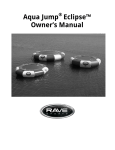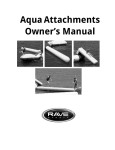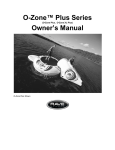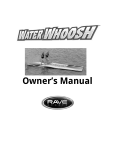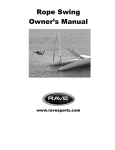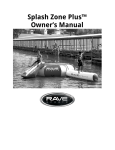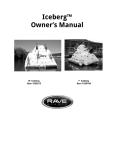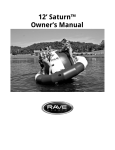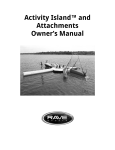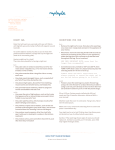Download RAVE Water Sports Equipment User Manual
Transcript
Bongo™ Owner’s Manual 10-FOOT MODEL 13-FOOT MODEL Safety Rules and Information • Read and understand all of the information contained in this owner’s manual before assembling and using your product. • Make sure that everyone who uses the product is provided with and understands these safety rules and information. • The Bongo is designed to be used on land or in large bodies of water with depths of at least 8 feet of water. Do not use or allow anyone else to use the product in swimming pools. • Choose a location for your product that is most protected from wind, of sufficient water depth, and free of obstructions. • Always anchor the Bongo securely before it is used on water. • Always wear a U.S. Coast Guard approved Type III (PFD) vest when using the product. • Never use the product after sunset, before dawn, or any other time in poor lighting conditions. • Never use the product in rough surface water conditions, during storms, or when there is lightning. If an unexpected storm arises while using the product, seek shelter on shore. Do not stay on the product. • Never use the product under the influence of alcohol or drugs. • Always stay under control while using the product. • Do not allow more than three people (500 lbs. max) to lounge on the 10ft. Bongo or more than five people (700 lbs. max) to lounge on the 13ft. Bongo at one time. For either product, allow only one person (240 lbs. max) to bounce on the Bongo at one time. • Never swim or play under or around the Bongo. • Never dive off of the Bongo head first. If you choose to jump off the product, always enter the water feet first. • Never use the product while tired or fatigued. Use extreme caution while swimming between the shore and the product. Do not attempt to swim this distance if you are tired or fatigued. • Always inspect the areas around and under the product before each use to ensure the water is deep enough and free of all rocks, logs, sand bars, and underwater obstructions and that the product is a safe distance from above water hard objects. Ask about local water conditions before using the product in unfamiliar water. • When not in use, secure the product against unauthorized or unsupervised use. • Inspect your product for any worn, defective, or missing parts. • Do not attempt flips, somersaults or other acrobatic maneuvers on the product. Most debilitating spinal cord injuries that occur during trampoline use involve somersaults. Improper landing during a somersault produces serious risk of broken bones, cuts, nerve damage, spinal cord or brain injury, or death. • Use the Bongo only under mature, knowledgeable adult supervision. • Not recommended for children under the age of six. • Do not over inflate. Over inflation can cause seam rupture. • When using on land, always maintain adequate clearance from hard surfaces or obstructions above and around this product. Use on soft sand or place shock-absorbing material around ground perimeter. Inflating Your Bongo Step 1 Lay the Bongo on a flat surface. Make sure there are no sharp objects under the product that might puncture the tube. Step 2 Locate the valve of the Bongo and unscrew the cap. We recommend using the High Speed Inflator/Deflator from RAVE Sports to inflate and deflate. (Part #01083) OPEN CLOSE To lock open valve, depress the stem and rotate ¼ turn clockwise. To close valve, depress the stem and rotate ¼ turn counter-clockwise. The valve stem should be in the depressed position while inflating. Replace cap on valve after inflation to ensure air tight seal. A special inflation adaptor is included with this product. If you are using the RAVE Sports High Speed Inflator, simply lock the adaptor onto the end of the inflation hose and insert into the valve body. Turn ¼ turn to lock in place. NOTE: This inflation adaptor will automatically open the valve when inserted and will close the valve when removed. You do not need to manually open/close the valve when using this special adaptor. If you will be using another inflation device with a larger nozzle, use the 1 ¼” diameter coupler (included) between the valve adaptor and the hose of your inflator. Make sure the hose is attached to the blower port of the Coupler Adaptor vacuum for inflation. Insert the adapter into the air valve and lock into place by turning clockwise. Inflate until the tube is firm and resistant to pressure. Your fist should create only a slight depression when pushed against the tube and the surface should be stretched taut in all directions. Replace cap to ensure an air tight seal. NOTE: It is normal for the air pressure within the tube to fluctuate depending on air and water temperatures. It may be necessary to increase or decrease the air pressure in your product accordingly. To avoid damage on extremely hot days it may be necessary to check and release the air pressure from your product throughout the day. ! CAUTION DO NOT OVER-INFLATE. Do not exceed 2 PSI if filling with compressed air. Excessive pressure can cause the tube to rupture with potentially damaging force to eyes, ears, skin and limbs. Use of an air compressor or over-inflation can rupture the tube beyond repair, thus voiding the warranty. Attaching the Ladder Step 1 The ladder consists of two pieces: a ladder with straps and a molded plastic ladder stabilizer. Orient the stabilizer on the notched side of the top two ladder steps and the curved portion is facing upwards towards the top of the ladder. While maintaining this orientation, flip the ladder upside down to expose the underside of the steps. Curved portion Step 2 Line up the large opening of the keyhole slots with the four bolts on the underside of the top two steps. Step 3 Slide the stabilizer towards the ladder to fully engage the bolts in the narrow end of the slots. Tap the stabilizer with your hand to ensure the bolts are fully engaged in the slots. Note: If the stabilizer feels loose after mounting, tighten the bolts slightly leaving minimal clearance between the bolt flange and the plastic stabilizer. This slight clearance will allow the stabilizer to be easily removed by hand (without tools) for storage. To remove stabilizer, simply slide in opposite direction. Step 4: To use on water, attach the ladder in the center of the blue panel to the left of the yellow panel that contains the air valve. The warning label on the bounce surface must be visible to anyone climbing the ladder. Right side strap Attach the ladder by looping the quick link, and webbing around Bongo lacing rope so the quick link finishes on the underside of the webbing strap as shown in the first picture. Weave the quick link into the webbing loop just above the second handle. Turn the nut until tightly closed. Attached correctly, the quick link connection should be covered by the top webbing strap. The straps should be as close to parallel as possible. IMPORTANT: It is critical that you loop the webbing properly around the rope so that they do not rub against the vinyl (see photos). CORRECT. The left side of the ladder should be attached to the left of the black loop. (The right side of ladder, not shown, should be to the right of the black loop.) The webbing’s inside edge should rest against the black nylon loop that surrounds the lacing rope. INCORRECT. The webbing must not pull against the vinyl loops. Rubbing the vinyl may cause premature wear and tear. Step 5 When properly installed, the ladder will hang with the curved portion of the stabilizer against the underside of the Bongo. Photo shown with Bongo out of water to show proper ladder orientation. Step 6 Attach an anchoring device to the ring or mount on the inner surface of the tube just above the water line, opposite of the ladder. Note: For seasonal anchoring situations, it is important to use an anchor weighing a minimum of 80 lbs. The Bongo is now ready to use! Please read and follow all safety instructions before enjoying your Bongo. RAVE Sports Raft Water Sports










